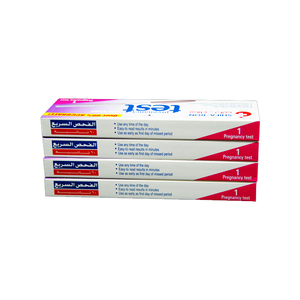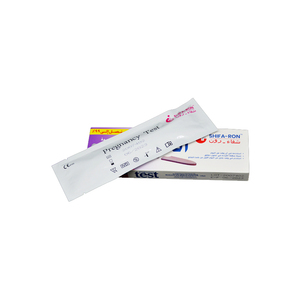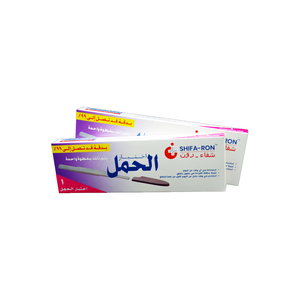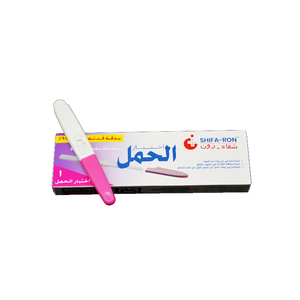(702 products available)









































































































































































































There are several types of early detection, one-step pregnancy tests that healthcare buyers can consider stocking in their medical or drugstore business. These tests vary in factors such as sensitivity, testing method, and results format. Below is a breakdown of the available types:
Hormone-Sensitive Tests
These tests are based on the hormone levels in urine, specifically on the human chorionic gonadotropin (hCG) hormone. Such tests are hCG hormone-sensitive, meaning they can detect low levels of this hormone. Most ladies use these tests a few days or 27-30 days after conception when the hormone is dominantly present in urine. These are single-step tests, so it's convenient to test without the need for complex instructions.
Strip Tests
This is one of the most common types, featuring a simple dip-and-read mechanism. Pregnancy test strips are dropped into a urine sample to give results within 5–10 minutes, indicated by colored lines on the strip. These are good because they can be cheap and useful for many women. Multi-line strip tests primarily serve their function in detecting pregnancy while serving as a single-step solution in practicality.
Cassette Tests
Cassette tests require respondents to place a urine sample in a designated area, usually through a dropper. It functions similarly to a test kit with compact cassettes for early one-step pregnancy tests. Pregnancy test cartridges possess high pregnancy detection sensitivity and are, therefore, very essential in drugstores and medical businesses.
Midstream Tests
Midstream test devices are like home reproductive detectors where one urinates directly on the test stick. Most of these are one-step because they are easy to use and do not require containers for holding the urine.
Digital Tests
Digital test screens use cutting-edge methodologies to present results through screens with clear indicators like 'pregnant' or 'not pregnant.' Whilst known widely for their clarity and lack of ambiguity, these tend to be expensive compared to non-digital one-step tests. Nevertheless, people like to have advanced devices; digital early pregnancy tests allow fans to get good results with good technology and no error lines.
One of the main priorities for healthcare buyers in choosing early detection one-step pregnancy tests is being relevant to the customers and the market. Several important considerations are outlined below:
Test Sensitivity
Detecting low levels of hCG requires a test with high sensitivity. Buyers should consider stocking those with sensitivity levels from 20 mIU/ml to 25 mIU/ml, as they can detect pregnancies a few days before the menstrual cycle begins.
Test Specificity
Specificity means correctly identifying that it is hCG and not other related hormones with a similar structure. High test specificity reduces the probability of a positive test result because of a false apprehension that one is pregnant. This is particularly important in cases where strict accuracy is needed, such as in fertility clinics.
Ease of Use
One-step tests should be user-friendly for both medical staff and patients. Midstream and cassette tests allow simple single-step testing without interpretation of complex instructions. In drug stores, self-testing customers will choose those that are easier to carry out with fewer procedural needs.
Test Range
Pregnancy tests should be able to work in a large area of hormone concentration. This means that the product is designed to allow people with different hormone levels due to certain health conditions or contraceptives to achieve accuracy. This feature would mean that the test is not limited and can be used often across various customers.
Container and Test Kit Durability
It is necessary to consider the quality of the kits. For health specialists, consider cases that are appropriate for other instruments, do not break easily, or are damaged during shipping or handling. In retail, if pregnancy test kits are broken, that leads to losses for many businesses. Also, consider the shelf life of test kits so they can sell fresh products.
Certification and Compliance
Ensure that the test complies with all requirements set by medical authorities. In pregnancy tests, people seek those that have been tested and found to be effective by experts, such as food and drug agencies and other medical clinics. Often, such tests would demonstrate performance metrics in terms of sensitivity, accuracy, etc.
Early detection one step pregnancy test must have positive and reliable npert and epert in pregnancy tests, and multi-line digital tests should not be odel and effed out for selling in health cneters.
A good understanding of the specifications and maintenance requirements for the early detection one-step pregnancy test helps ensure the quality of these products so end users can achieve accurate results. Here are key points relating to the specifications of these tests and their maintenance requirements:
Test Sensitivity
The sensitivity of these tests should be in the range of 20 to 25 mIU/ml. This means the test can detect low amounts of hCG in urine, especially when it is early in the pregnancy. There are some more sensitive tests that can detect levels of hCG as low as 10 mIU/ml.
Specificity
This is because there may be confusion between hCG and other hormones, such as luteinizing hormone (LH), leading to an erroneous positive result in the early days. Close attention must be given to the reagents used in the kits to avoid such a situation. It is also necessary for multiletter tests where women in question could be experiencing false pregnancies are barred from using them.
Temperature and Humidity Conditions
Consider the working temperature and humidity of the pregnancy test kits. Most want to stay in either of the ranges of 15–30 °C and of 30–60% humidity. Outside of this range affects the accuracy of the test; therefore, one must ensure it is at the right temperature while storing them in drug rmsontmzn&sc3. When customers order large numbers of pregnancy tests, they should be told to keep them in the right conditions while distributing them to other health facilities.
Sample Type
The test should be able to use urine as the only available biological sample. Most early one-step pregnancy tests are designed to work best with first-morning urine since that is when the concentration of hCG is at the highest. Buyers of these tests should inform users that urine taken at any other time of the day might not give the right concentration of the hormone and, hence, should be advised insistently to take it early in the morning.
Storage Conditions
Pregnancy tests must be kept in dry conditions. Do not expose them to any forms of heat, including direct sunlight, as this could damage the test reagents. Their storage in drug stores should always be in cool and dry environments away from direct exposure to heat sources.
Expiration Dates
Always check the expiration dates on pregnancy home test kits, as using an expired kit means that the components inside are weakened and results will be inaccurate. Those tests with short shelf lives need to be rotated often in stock.
Handling
For people who work with these tests, they need to be careful with them, as they are delicate. The handling of these domestic instruments should not include jostling them to break their inner parts or raining on them to burn. Another factor that can affect the accuracy of these tests is when they come into contact with moisture.
Training Staff
In drug stores, staff should have knowledge of how to handle these one-step tests appropriately, what the storage requirements are, and how expiration dates are checked. Also, it should be explained to customers how to properly store these tests at home to maintain their effectiveness.
A1: As long as the test is sensitive enough, it can detect pregnancy as early as six days after conception.
A2: Both work identically, but a digital test shows a clear positive or negative message instead of lines, removing any confusion.
A3: A false positive indicates pregnancy when there is none, while a false negative suggests no pregnancy when there is. Several factors can contribute to these, including using an expired test kit or testing at the wrong time.
A4: The best time to test is in the morning, as urine is more concentrated, providing more accurate results.
A5: Yes, certain conditions like ovarian cysts or using hormone medications can affect the accuracy of the test.
A6: It typically recommends holding the test in the urine for about 5 seconds, but one should always refer to the specific product instructions.
A7: No, these tests should be stored in a cool, dry place, but they should not be exposed to cold temperatures like refrigerators.